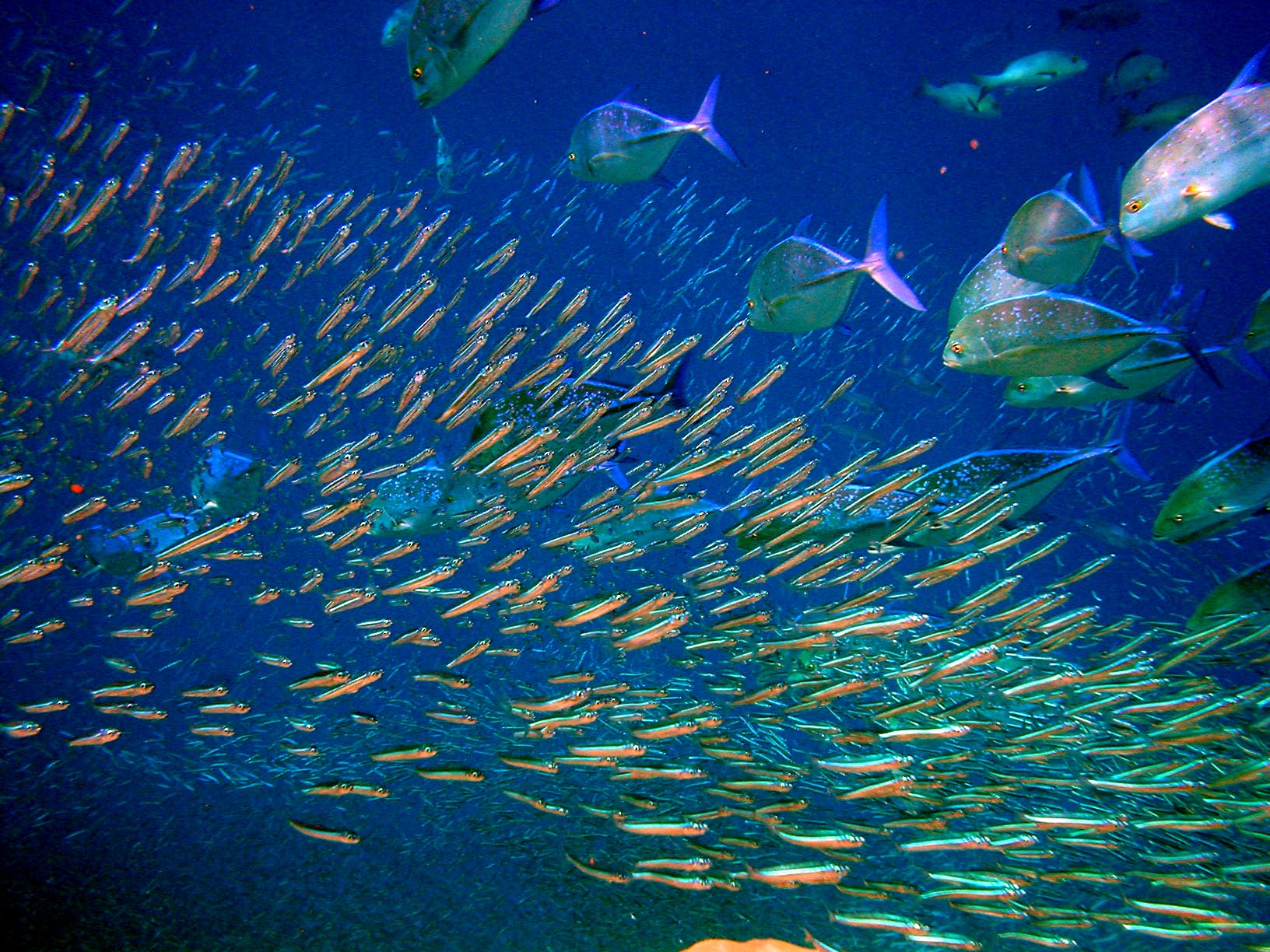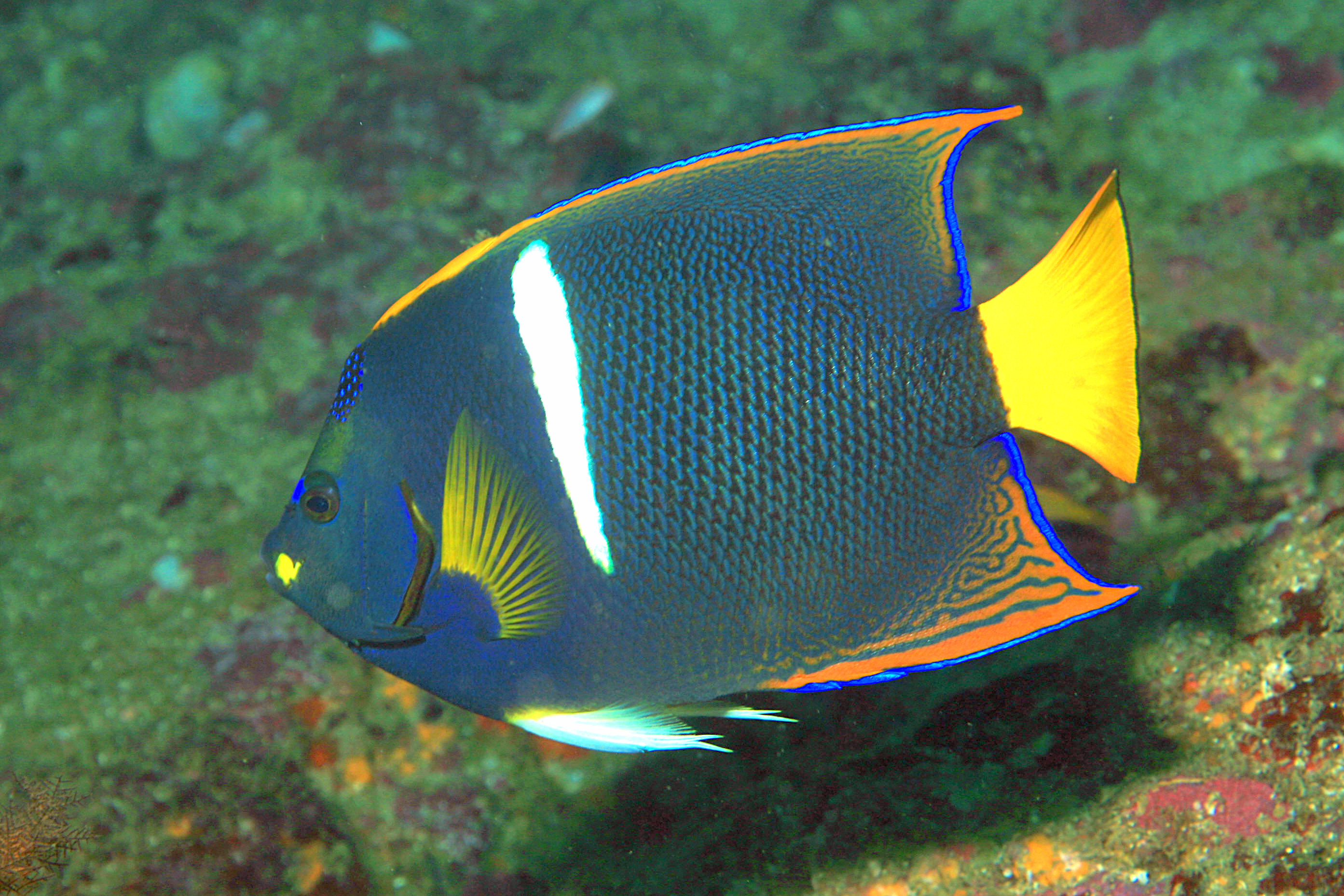|
Coral Reef Fish
Coral reef fish are fish which live amongst or in close relation to coral reefs. Coral reefs form complex ecosystems with tremendous biodiversity. Among the myriad inhabitants, the fish stand out as colourful and interesting to watch. Hundreds of species can exist in a small area of a healthy reef, many of them hidden or well camouflaged. Reef fish have developed many ingenious specialisations adapted to survival on the reefs. Coral reefs occupy less than 1% of the surface area of the world oceans, but provide a home for 25% of all marine fish species. Reef habitats are a sharp contrast to the open water habitats that make up the other 99% of the world oceans. However, loss and degradation of coral reef habitat, increasing pollution, and overfishing including the use of destructive fishing practices, are threatening the survival of the coral reefs and the associated reef fish. Overview Coral reefs are the result of millions of years of coevolution among algae, invertebra ... [...More Info...] [...Related Items...] OR: [Wikipedia] [Google] [Baidu] |
Underwater World
Underwater World may refer to: *Underwater World, Singapore, oceanarium in Singapore *UnderWater World, Queensland, marine mammal park, oceanarium and wildlife sanctuary in Queensland, Australia *UnderWater World Guam, oceanarium in Guam *Kelly Tarlton's Sea Life Aquarium, formerly Kelly Tarlton's Underwater World – Public aquarium in Auckland, New Zealand *Nanjing Underwater World, aquarium in Nanjing, China *The Aquarium of Western Australia (AQWA), formerly Underwater World, Perth, aquarium in Hillarys, Western Australia *SEA LIFE Minnesota Aquarium, aquarium in Bloomington, Minnesota *Underwater World (song), a 1984 song by Hanoi Rocks {{geodis ... [...More Info...] [...Related Items...] OR: [Wikipedia] [Google] [Baidu] |
Yellow Tang
The yellow tang (''Zebrasoma flavescens''), also known as the lemon sailfin, yellow sailfin tang or somber surgeonfish, is a species of marine ray-finned fish belonging to the family Acanthuridae which includes the surgeonfishes, unicornfishes and tangs. Bright yellow in color, it is one of the most popular marine aquarium fish, though in its natural state, it lives in reefs. The yellow tang spawns around a full moon, eats algae, and has a white barb, located just before the tail fin, to protect itself. Taxonomy and etymology The yellow tang was first formally described by English naturalist Edward Turner Bennett as ''Acanthurus flavescens'' in 1828 from a collection in the Hawaiian Islands. ''Zebrasoma'' refers to the body and the zebra-like stripes or bars on the body of the type species the genus, the sailfin tang ('' Z. velifer''). Its species name is the Latin adjective , which refers to the tang's yellow color. Within the genus '' Zebrasoma'' the yellow tang for ... [...More Info...] [...Related Items...] OR: [Wikipedia] [Google] [Baidu] |
Epipelagic Fish
Pelagic fish live in the pelagic zone of ocean or lake waters—being neither close to the bottom nor near the shore—in contrast with demersal fish that live on or near the bottom, and reef fish that are associated with coral reefs. The marine pelagic environment is the largest aquatic habitat on Earth, occupying 1,370 million cubic kilometres (330 million cubic miles), and is the habitat for 11% of known fish species. The oceans have a mean depth of . About 98% of the total water volume is below , and 75% is below .#Moyle, Moyle and Cech, p. 585 Marine pelagic fish can be divided into coastal (inshore) fish and oceanic (offshore) fish. Coastal fish#Coastal pelagic fish, Coastal pelagic fish inhabit the relatively shallow and sunlit waters above the continental shelf, while #Oceanic fish, oceanic pelagic fish inhabit the vast and deep waters beyond the continental shelf (even though they also may swim inshore). Pelagic fish range in size from small coastal forage fis ... [...More Info...] [...Related Items...] OR: [Wikipedia] [Google] [Baidu] |
Queen Angelfish
The queen angelfish (''Holacanthus ciliaris''), also known as the blue angelfish, golden angelfish, or yellow angelfish, is a species of Pomacanthidae, marine angelfish found in the western Atlantic Ocean. It is a benthic zone, benthic (ocean floor) warm-water species that lives in coral reefs. It is recognized by its blue and yellow coloration and a distinctive spot or "crown" on its forehead. This crown distinguishes it from the closely related and similar-looking Bermuda blue angelfish (''Holacanthus bermudensis''), with which it overlaps in range and can interbreed. Adult queen angelfish are selective feeders and primarily eat sponges. Their social structure consists of harem (zoology), harems which include one male and up to four females. They live within a territory (animal), territory where the females forage separately and are tended to by the male. Spawn (biology), Breeding in the species occurs near a full moon. The transparent Ichthyoplankton, eggs float in the water ... [...More Info...] [...Related Items...] OR: [Wikipedia] [Google] [Baidu] |
Swim Bladder
The swim bladder, gas bladder, fish maw, or air bladder is an internal gas-filled organ (anatomy), organ in bony fish that functions to modulate buoyancy, and thus allowing the fish to stay at desired water depth without having to maintain lift (force), lift via swimming, which expends more energy. Also, the Dorsum (biology), dorsal position of the swim bladder means that the expansion of the bladder moves the center of mass downwards, allowing it to act as a stabilizing apparatus. Additionally, the swim bladder functions as a resonating chamber (anatomy), resonating chamber to produce or receive sound. The swim bladder is evolutionarily homology (biology), homologous to the lungs of tetrapods and lungfish, and some ray-finned fish such as bowfins have also evolved similar respiratory functions in their swim bladders. Charles Darwin remarked upon this in ''On the Origin of Species'', and reasoned that the lung in air-breathing vertebrates had derived from a more primitive swim b ... [...More Info...] [...Related Items...] OR: [Wikipedia] [Google] [Baidu] |
Decibel
The decibel (symbol: dB) is a relative unit of measurement equal to one tenth of a bel (B). It expresses the ratio of two values of a Power, root-power, and field quantities, power or root-power quantity on a logarithmic scale. Two signals whose level (logarithmic quantity), levels differ by one decibel have a power ratio of 101/10 (approximately ) or root-power ratio of 101/20 (approximately ). The strict original usage above only expresses a relative change. However, the word decibel has since also been used for expressing an Absolute scale, absolute value that is relative to some fixed reference value, in which case the dB symbol is often suffixed with letter codes that indicate the reference value. For example, for the reference value of 1 volt, a common suffix is "#Voltage, V" (e.g., "20 dBV"). As it originated from a need to express power ratios, two principal types of scaling of the decibel are used to provide consistency depending on whether the scaling refer ... [...More Info...] [...Related Items...] OR: [Wikipedia] [Google] [Baidu] |
Batrachoididae
Batrachoididae is the only family in the ray-finned fish order Batrachoidiformes . Members of this family are usually called toadfish or frogfish: both the English common name and scientific name refer to their toad-like appearance (''batrakhos'' is Greek for frog). Toadfish are benthic ambush predators that favor sandy or muddy substrates where their cryptic coloration helps them avoid detection by their prey. Toadfish are well known for their ability to "sing", males in particular using the swim bladder as a sound-production device used to attract mates. Evolution Toadfish are among the most basal percomorph orders, and are thought to have diverged from their closest relatives in the Late Cretaceous. The earliest known toadfish is likely '' Bacchiaichthys'' from the Late Cretaceous (Maastrichtian) of Italy, which very closely resembles modern toadfish and is one of the earliest known percomorphs. Its status as a toadfish has been disputed, as it is noted to have some tr ... [...More Info...] [...Related Items...] OR: [Wikipedia] [Google] [Baidu] |
Guinness Book Of World Records
''Guinness World Records'', known from its inception in 1955 until 1999 as ''The Guinness Book of Records'' and in previous United States editions as ''The Guinness Book of World Records'', is a British reference book published annually, listing world records both of human achievements and the extremes of the natural world. Sir Hugh Beaver created the concept, and twin brothers Norris and Ross McWhirter co-founded the book in London in August 1955. The first edition topped the bestseller list in the United Kingdom by Christmas 1955. The following year the book was launched internationally, and as of the 2025 edition, it is now in its 70th year of publication, published in 100 countries and 40 languages, and maintains over 53,000 records in its database. The international franchise has extended beyond print to include television series and museums. The popularity of the franchise has resulted in ''Guinness World Records'' becoming the primary international source for catal ... [...More Info...] [...Related Items...] OR: [Wikipedia] [Google] [Baidu] |
Dwarf Seahorse
The dwarf seahorse (''Hippocampus zosterae'') is a species of seahorse found in the subtidal aquatic beds of the Bahamas and parts of the United States. It is threatened by habitat loss. According to ''Guinness World Records'', it is the slowest-moving fish, with a top speed of about per hour.Guinness Book of World Records (2009) It is most often white in color but can range from tan, brown, yellow and green. In the wild, it often has small skin growths called cirri that resemble algae. Description Like other seahorses, the dwarf seahorse has a head angled at right angles to its body and swims upright using its dorsal fin to propel it and its pectoral fins to steer. It grows to an average length of , with a maximum length of . The dwarf seahorse can live up to 2 years, but most commonly live around 1. It can be found in colors of beige, yellow, green, and black and may have white speckles, dark spots or protrusions and is well-camouflaged, the coloring usually matching the g ... [...More Info...] [...Related Items...] OR: [Wikipedia] [Google] [Baidu] |
Sea Horse
A seahorse (also written ''sea-horse'' and ''sea horse'') is any of 46 species of small marine bony fish in the genus ''Hippocampus''. The genus name comes from the Ancient Greek (), itself from () meaning "horse" and () meaning "sea monster" or "sea animal". Having a head and neck suggestive of a horse, seahorses also feature segmented bony armour, an upright posture and a curled prehensile tail. Along with the pipefishes and seadragons ('' Phycodurus'' and '' Phyllopteryx'') they form the family Syngnathidae. Evolution and fossil record Anatomical evidence, supported by molecular, physical, and genetic evidence, demonstrates that seahorses are highly modified pipefish. The fossil record of seahorses, however, is very sparse. The best known and best studied fossils are specimens of '' Hippocampus guttulatus'' (though literature more commonly refers to them under the synonym of ''H. ramulosus''), from the Marecchia River formation of Rimini Province, Italy, datin ... [...More Info...] [...Related Items...] OR: [Wikipedia] [Google] [Baidu] |
Seven-figure Pygmy Goby
''Eviota sigillata'', commonly called seven-figure pygmy goby or adorned dwarfgoby, is a species of marine fish in the family Gobiidae. They are widespread throughout the tropical waters of the Indo-West Pacific area, from the Seychelles to the Micronesia. It inhabits reef A reef is a ridge or shoal of rock, coral, or similar relatively stable material lying beneath the surface of a natural body of water. Many reefs result from natural, abiotic component, abiotic (non-living) processes such as deposition (geol ... habitats at depths from . This species has the shortest lifespan for a vertebrate, living for at most 59 days.Le Page, M., 2005Reef fish lives fastest, dies youngest New Scientist 25 April 2005 (NewScientist.com). About three weeks are as pelagic larvae, two weeks settling on the reef and three weeks as adults. This pygmy goby can reach a length of .Kuiter, R.H. and T. Tonozuka, 2001. Pictorial guide to Indonesian reef fishes. Part 3. Jawfishes - Sunfishes, Opi ... [...More Info...] [...Related Items...] OR: [Wikipedia] [Google] [Baidu] |
Goby
The Gobioidei are a suborder of percomorph fish. Many of these fishes are called gobies. It is by far the largest and most diverse order within the order Gobiiformes, and one of the most diverse groups of ray-finned fish in general. The suborder, which was previously considered a suborder of Perciformes, is made up of about 2,211 species that are divided between seven families. Phylogenetic relationships of the Gobioidei have been elucidated using molecular data. Gobies are primarily small species, often with large heads and tapered bodies, that live in marine water, but roughly 10% of these species inhabit fresh water. This order is composed chiefly of benthic or burrowing species; like many other benthic fishes, most gobioids do not have a gas bladder or any other means of controlling their buoyancy in water, so they must spend most of their time on or near the bottom. Traditionally most of the species called gobies have been classified in the order Perciformes as the subord ... [...More Info...] [...Related Items...] OR: [Wikipedia] [Google] [Baidu] |







